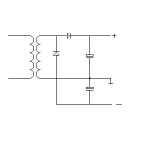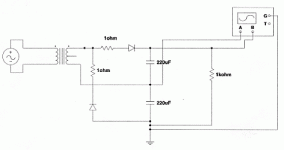can anyone point a schematic out to me? I am confused as to where the ground comes from without the center tap ??
Basically from one secondary you can get one rail and ground. Just follow describtion on a rect. bridge. I wonder myself is there a clever way to get somehow +/- and ground. This information could be useful for Aleph X.😉
you can take a pair of voltage regulators, pos and net, tie their commons together and derive a ground that way.
1 winding, 2 rails.
You could use a voltage doubler cct with the non-diode end of the transformer winding earthed as the zero volt point. Downside is that each rail has twice the normal ripple so would need big caps.
GP.
You could use a voltage doubler cct with the non-diode end of the transformer winding earthed as the zero volt point. Downside is that each rail has twice the normal ripple so would need big caps.
GP.
You can generate an "electronic" ground at the center of a single supply. The input and feedback are DC coupled to it, the low impedance load being AC coupled by the power supply capacitors. A good example here, in a QUAD power amp 🙂 :
http://iquebec.ifrance.com/QuadFranco/schemas/amp_306.jpg
http://iquebec.ifrance.com/QuadFranco/schemas/amp_306.jpg
A few extra precisions as the QUAD schematic is fairly non-standard :
The center point is generated by R28-R29, amplified by T11-T12-R30-R31(a unity-gain buffer), and C10-C11 are the filter capacitors. As you can see, there is NO center point on the secondary of the transformer. The buffer must have the DC current capability for the bias and feedback, but not for the load, which sees the two filter capacitors in parallel connected to the center point(Thevenin equivalent circuit). I think this circuit must be wired with special care for current returns...
The project32 (i think) from ESP pages is based on the same idea for lower voltages, and a Texas Instrument chip TLE2426 does the same job.
The center point is generated by R28-R29, amplified by T11-T12-R30-R31(a unity-gain buffer), and C10-C11 are the filter capacitors. As you can see, there is NO center point on the secondary of the transformer. The buffer must have the DC current capability for the bias and feedback, but not for the load, which sees the two filter capacitors in parallel connected to the center point(Thevenin equivalent circuit). I think this circuit must be wired with special care for current returns...
The project32 (i think) from ESP pages is based on the same idea for lower voltages, and a Texas Instrument chip TLE2426 does the same job.
As long as you aren't pumping a lot of current through the
load as with a (non-balanced) power amp, you can do well
with forming a voltage divider with two equal value power
resistors and putting them across the supply. Where they
join is the new virtual ground, and you put a big fat cap
from there to the real ground. Voila!

load as with a (non-balanced) power amp, you can do well
with forming a voltage divider with two equal value power
resistors and putting them across the supply. Where they
join is the new virtual ground, and you put a big fat cap
from there to the real ground. Voila!

Since output stage of AlephX doesn't use and need the ground as such, would it be preferable to place filter caps directly across both rails (especially if they are lower in voltage) and use virtual ground only for the input stage. Any gains of such an approach?. It has been talked before, but nobody really gave a clear answer.
I don't know that it would be preferrable. If you accidentally
found yourself driving ground with the output of the amp,
it might get a little exciting, so I don't do it.
found yourself driving ground with the output of the amp,
it might get a little exciting, so I don't do it.
I used the supply splitter arrangement for a bridged amplifier. The output current never runs through the derived ground. Worked great.
I would use a resistor divider to get a ground, but the divider should draw as much power as the amp at full power if you ground your speaker to it. Wasteful but effective.😎
- Status
- Not open for further replies.
- Home
- Amplifiers
- Solid State
- power supply from one secondary

